Topics
Reproduction in Lower and Higher Plants
- Reproduction
- Mode of Reproduction in Plant
- Asexual Reproduction in Plant
- Vegetative Reproduction
- Natural Vegetative Reproduction
- Artificial Vegetative Reproduction
- Sexual Reproduction in Flowering Plants
- Pre-fertilization in Plant: Structure and Events
- Pre-fertilization in Plant: Stamen (Male Reproductive Unit)
- Pre-fertilization in Plant: Microsporangium
- Structure of Microspore Or Pollen Grain
- Pre-fertilization in Plant: Pistil (Female Reproductive Unit)
- Pre-fertilization in Plant: Megasporangium
- Pre-fertilization in Plant: Formation of Embryo Sac
- Pollination
- Self Pollination (Autogamy)
- Cross Pollination
- Agents of Pollination
- Outbreeding Devices
- Pollen Pistil Interaction
- Fertilization Process
- Post Fertilisation in Plant: Structures and Events
- Development of Endosperm
- Post Fertilization in Plant: Development of Embryo (Embryogeny)
- Formation of Seed and Fruit
- Apomixis
- Parthenocarpy
- Polyembryony
- Kinds of Pollination
Reproduction in Lower and Higher Animals
- Reproduction
- Mode of Reproduction in Animal
- Asexual Reproduction in Animal
- Sexual Reproduction in Animals
- Human Reproduction
- The Male Reproductive System
- The Female Reproductive System
- Menstrual Cycle (Ovarian Cycle)
- Gametogenesis
- Fertilization in Human
- Embryonic Development in Human
- Implantation in Human
- Pregnancy in Humans
- Placenta (Growth) in Human
- Parturition (Birth) in Human
- Lactation in Human
- Reproductive Health
- Population Stabilisation and Birth Control
- Medical Termination of Pregnancy (MTP)
- Sexually Transmitted Diseases (STD)
- Infertility
- Gastrulation in humans
Inheritance and Variation
- Heredity or Inheritance
- Gregor Johann Mendel – Father of Genetics
- Genes and Genetic
- Mendelian Inheritance - Mendel’s Law of Heredity
- Back Cross and Test Cross
- Deviations from Mendel’s Findings
- Chromosomal Theory of Inheritance
- Chromosomes - The Carriers of Heredity
- Linkage and Crossing Over
- Autosomal Inheritance
- Sex Linked Inheritance
- Sex Determination
- Genetic Disorders
Molecular Basis of Inheritance
- Deoxyribonucleic Acid (DNA) and Its Structure
- The Genetic Material is a DNA
- Packaging of DNA Helix
- DNA Replication
- Protein Synthesis
- Regulation of Gene Expression
- Operon Concept
- Genomics
- Human Genome Project
- DNA Fingerprinting Technique
- Genetic Code
Origin and Evolution of Life
- Origin and Evolution of Universe and Earth
- Theories of Origin of Life
- Chemical Evolution of Life (Self-assembly Theory of the Origin of Life)
- Darwinism
- Mutation Theory
- Modern Synthetic Theory of Evolution
- Organic Evolution
- Hardy Weinberg’s Principle
- Adaptive Radiation
- Evidences for Biological Evolution
- Speciation
- Geological Time Scale
- Human Evolution
- Theories of Biological Evolution
Plant Water Relation
- Plant Water Relation
- Properties of Water
- Water absorbing organ
- Water Available to Roots for Absorption
- Means of Transport in Plants
- Concept of Imbibition
- Simple Diffusion
- Concept of Osmosis
- Osmotic Pressure
- Facilitated Diffusion
- Turgidity and Flaccidity (Plasmolysis)
- Active Transport
- Passive Transport
- Water Potential (ψ)
- Path of Water Across the Root
- Translocation of Water (Ascent of Sap)
- Transport of Mineral Ions
- Transport of Food
- Transpiration
- Types of Transpiration
- Structure of Stomatal Apparatus
- Significance of Transpiration
Plant Growth and Mineral Nutrition
- Plant Growth
- Phases of Plant Growth
- Conditions Necessary for Plant Growth
- Plant Growth Rate
- Plant Growth Curve
- Differentiation, De-differentiation, Re- Differentiation
- Plant Development
- Plant Plasticity
- Plant Hormones
- Types of Plant Hormones: Auxins
- Types of Plant Hormones: Gibberellins
- Types of Plant Hormones: Cytokinins
- Types of Plant Hormones: Ethylene
- Types of Plant Hormones: Abscisic Acid (ABA)
- Photoperiodism
- Vernalization (Yarovization)
- Plant Mineral Nutrition
- Nitrogen Cycle
Respiration and Circulation
- Respiration
- Organs of Respiratory Exchange
- Human Respiratory System
- Mechanism of respiration-Breathing
- Regulation of Breathing / Respiration
- Modified Respiratory Movements
- Disorders of Respiratory System
- Transportation in Living Organisms
- Circulation in Animals
- Types of Closed Circulation
- Blood Circulatory System in Human
- Composition of Blood: Plasma (The Liquid Portion of Blood)
- Composition of Blood: Red Blood Cells (Erythrocytes)
- Composition of Blood: White Blood Cells (Leukocytes)
- Composition of Blood: Blood Platelets (Thrombocytes)
- Function of Platelets - Clotting of Blood (Coagulation)
- Human Heart
- Working mechanism of human heart
- Blood Vessels
- Blood Pressure (B.P.)
- Electrocardiogram (ECG)
- Lymph and Lymphatic System
- Mechanism of respiration - Internal respiration
- Mechanism of respiration - External respiration
- Mechanism of respiration - Cellular respiration
Control and Co-ordination
- Control and Co-ordination
- Nervous System in Hydra
- Nervous System in Planaria (Flatworm)
- Neural Tissue
- Neuron (Or Nerve Cell) and Its Types
- Neuroglial Cells (Or Glial Cells)
- Human Nervous System
- Central Nervous System (CNS)
- The Human Brain - Forebrain
- The Spinal Cord
- Peripheral Nervous System (PNS)
- Sensory Receptors
- Human Eye
- Human Ear
- Disorders of Nervous System
- Chemical Coordination
- Human Endocrine System
- The Hypothalamus
- Pituitary Gland or Hypophysis Gland
- The Pineal Gland
- Thyroid Gland
- Parathyroid Gland
- Thymus Gland
- Adrenal Gland (Suprarenal Gland)
- Pancreas (Islets of Langerhans)
- Reproductive Glands (Gonads)
- Synapse - Properties of nerve fibres
- Synapse - Types of synapse
- Transmission of nerve impulse
- Generation of nerve impulse
- Reflex Action
- Autonomic Nervous System (ANS)
- Diffuse Endocrine Glands
Human Health and Diseases
- Defence System in Our Body: Immune System
- Immunity
- Types of Immunity
- Vaccination and Immunization
- Structure of Antibody
- Disease
- Protozoan Diseases
- Helminthic Diseases
- Bacterial Diseases
- Viral Diseases
- Fungal Diseases
- Vector Borne Diseases
- Cancer
- Adolescence
- Addiction
- Drug Abuse
Enhancement of Food Production
- Improvement in Food Production
- Plant Breeding
- Tissue Culture
- Single Cell Protein (SCP)
- Biofortification
- Animal Husbandry (Livestock)
- Animal Breeding
- Dairy Farming
- Poultry Farming
- Apiculture (Bee Farming)
- Pisciculture (Fish Farming)
- Sericulture
- Lac Culture
- Microbes in Human Welfare
- Microbes in Industrial Production
- Microbes in Sewage Treatment
- Microbes in Energy Generation
- Microbes as Biocontrol Agents
- Microbes as Biofertilizers
Biotechnology
- Biotechnology
- Process and Principles of Biotechnology
- Methodology for rDNA Technology
- Commercial Applications of Biotechnology
- Bioethics
- Effects of Biotechnology on the Environment
- Biopatent and Biopiracy
- Transgenic Plants
- Transgenic animals
- Effects of Biotechnology on Human Health
- Tools and techniques for gene cloning/ rDNA technology
Organisms and Populations
- Organisms and the Environment Around
- Habitat
- Niche
- Structure and function of an Ecosystem
- Adaptations and Its Types
- Population
- Population Interactions
- Organisms and Populations
Ecosystems and Energy Flow
- Ecosystem
- Structure and function of an Ecosystem
- Concept of Energy Flow in an Ecosystem
- Classification of Animal
- Trophic Level
- Food Chain
- Food Web
- Ecological Pyramids
- Nutrient Cycles
- Ecological Succession
- Ecosystem Services
- Productivity
- Decomposition
- Phosphorus Cycle
- Carbon Cycle
Biodiversity, Conservation and Environmental Issues
- Biodiversity
- Levels of Biodiversity
- Patterns of Biodiversity
- Biodiversity Current Scenario
- Loss of Biodiversity
- Conservation of Wildlife
- Biological Diversity Act, 2002
- Environmental Issues
- Air Pollution and Its Causes
- Noise Pollution
- Water Pollution and Its Causes
- Green House Effect
- Preventive Measures of Green House Effect
- Global Warming
- Preventive Measures of Global Warming
- Ozone Layer Depletion
- Deforestation and Its Causes
- Mission Harit Maharashtra
- Conservation of Biodiversity
Excretion and Osmoregulation
- Modes of Excretion: Ammonotelism, Ureotelism, and Uricotelism
- Human Excretory System
- Function of the Kidney - “Production of Urine”
- Regulation of Kidney Function
- Common Disorders of the Urinary System
Human Reproduction
- Method of natural vegetative reproduction:
- Reproduction by Stem
- Reproduction by Leaf
- Reproduction by Root
- Advantages of natural vegetative reproduction
- Disadvantages of natural vegetative reproduction
Notes
Natural vegetative reproduction:
- Natural vegetative reproduction is a form of asexual reproduction in which a bud grows and develops into a new plant.
- The buds may be formed in organs such as root, stem, and leaf.
- At some stage, the new plant gets detached from the parent plant and starts to develop into a new plant.
- Some of the organs involved in vegetative reproduction also serve as the organs of storage and perennation.
- The unit of reproductive structure used in propagation is called reproductive propagules or diaspores.
Natural methods of vegetative reproduction:
-
Vegetative reproduction in root:
The roots of some plants develop vegetative or adventitious buds on them. Example Murraya, Dalbergia, and Millingtonia. Some tuberous adventitious roots apart from developing buds also store food. Example Ipomoea batatas and Dahlia. Roots possessing buds to become detached from the parent plant and grow into the independent plant under suitable condition.

Reproduction by roots - Sweet potato (Ipomoea batatas)
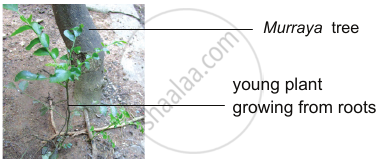
Reproduction by roots – Murraya
- Vegetative reproduction in leaf:
In some plants, adventitious buds are developed on their leaves. When they are detached from the parent plant they grow into new individual plants. Examples: Bryophyllum, Scilla, and Begonia. In Bryophyllum, the leaf is succulent and notched on its margin. Adventious buds develop at these notches and are called epiphyllous buds. They develop into new plants forming a root system and become independent plants when the leaf gets decayed. Scilla is a bulbous plant and grows in sandy soils. The foliage leaves are long and narrow and epiphyllous buds develop at their tips. These buds develop into new plants when they touch the soil.

Reproduction by leaf - Bryophyllum
-
Vegetative reproduction in stem: In some plants underground modified stems are -
A) Underground stem:
1. Bulb: It is a condensed conical or convex stem surrounded by fleshy scale leaves. They are of two types. Tunicated (coated) bulb: In which the stem is much condensed and surrounded by several concentric layers of scale leaves. The inner scales are commonly fleshy, the outer ones dry. They can be classified into two types (a) Simple Tunicated bulb Example: Allium cepa (b) Compound Tunicated bulb. Example: Allium sativum.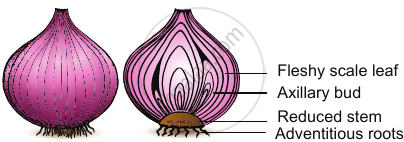
Tunicated bulb – Allium cepa (Onion)

Tunicated bulb - Allium sativum (Garlic)
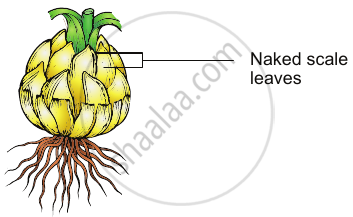
Naked – Lilium
2. Corm: This is a succulent underground stem with an erect growing tip. The corm is surrounded by scale leaves and exhibit nodes and internodes. Example: Amorphophallus, Colocasia, Colchicum
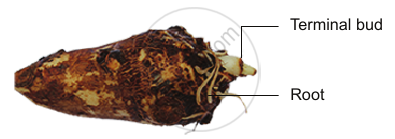
Corm – Colocasia
3. Rhizome: This is an underground stem growing horizontally with several lateral growing tips. Rhizomes possess conspicuous nodes and internodes covered by scale leaves. Example: Zingiber officinale, Canna, Curcuma longa, Musa paradisiaca.
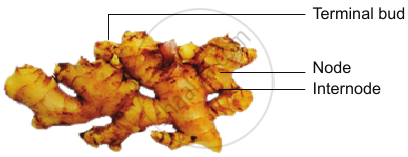
Rhizome – Zingiber officinale (Ginger)
4. Tuber: This is a succulent underground spherical or globose stem with many embedded axillary buds called “eyes”. Example: Solanum tuberosum, Helianthus tuberosus.
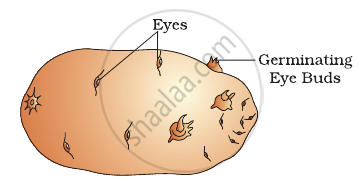
Tuber – Solanum tuberosum (potato)
B) Aerial steam:
1) Creepers: These are plants growing closer (horizontally) to the ground and produce roots at each node. Example: Cynodon dactylon, Centella.

Runner - Centella asiatica
C) Sub-aerial stem: Sub-aerial stem is found in plants with weak stems in which branches lie horizontally on the ground. These are meant for vegetative propagation. They may be sub-aerial or partially sub-terranean.
1) Runner: This is a slender, prostrate branch creeping on the ground and rooting at the nodes. Example: Oxalis (Wood sorrel), lawn grass (Cynodon dactylon).
 Runner - Oxalis
Runner - Oxalis
2) Stolon: This is also a slender, lateral branch originating from the base of the stem. But it first grows obliquely above the ground, produces a loop and bends down towards the ground. When touches the ground it produces roots and becomes an independent plantlet. Example: Mentha piperita (peppermint), Fragaria indica (wild strawberry).
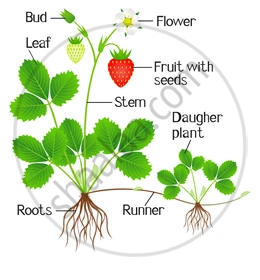
Stolon - Fragaria (Strawberry)
3) Sucker: Sucker develops from an underground stem and grows obliquely upwards and gives rise to a separate plantlet or new plant. Example: Chrysanthemum, Bambusa.
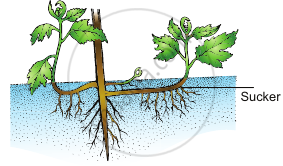
Sucker - Chrysanthemum
4) Offset: Offset is similar to runner but found in aquatic plants, especially in rosette-leaved forms. A short thick lateral branch arises from the lower Offset axil and grows horizontally leafless for a short distance, then it produces a bunch of rosette leaves and root at nodes. Example: Eichhornia Root (water hyacinth), Pistia (water lettuce).
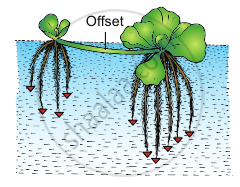
Offset - Pistia stratiotes
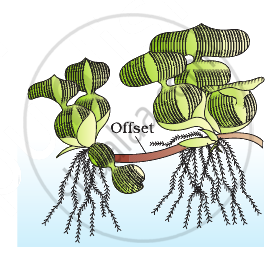
Offset - Water hyacinth
D) Bulbils (or specialized buds): Bulbils are modified and enlarged buds, meant for propagation. When bulbils detach from the parent plant and fall on the ground, they germinate into new plants and serve as a means of vegetative propagation. Example Agave and Allium proliferum, Dioscorea bulbifera,

Bulbil - Agave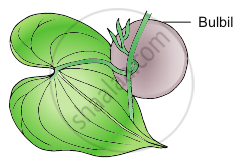
Axillary bulbils - Dioscorea bulbifera
5. Turions: There are special types of fleshy buds that develop in an aquatic plant which are called turions. E.g., Potamogeton, Utricularia.
| Vegetative Part | Examples |
| Roots | Murraya, Dalbergia, Millingtonia, Sweet potato (Ipomoea batatas), Tapioca, Yam, Dahlia, Tinospora, Dalbergia sisso, Populus, Guava, Murraya, Albizia lebbeck |
| Leaves | Bryophyllum, Scilla, Begonia, Strepto-carpus, Saintpaulia, Kalanchoe plant, and Walking fern |
| Steams | |
|
Onion, Garlic, and Lilies |
|
Amorphophallus, Colocasia, Colchicum, Gladiolus, Crocus, and Alocasia |
|
Zingiber officinale (Ginger), Canna, Curcuma longa, Musa paradisiaca, Turmeric, Lotus, etc. |
|
Solanum tuberosum (Potato), Helianthus tuberosus |
|
Cynodon dactylon, Centella |
|
Oxalis (Wood sorrel), lawn grass (Cynodon dactylon). |
|
Mentha piperita (peppermint), Fragaria indica (wild strawberry), and Vallisneria |
|
Bambusa, Mint and Chrysanthemum |
|
Eichhornia Root (water hyacinth), Pistia (water lettuce) |
|
Agave, Allium proliferum, Dioscorea bulbifera, Oxalis, Dentaria, Globba, Agave, Lilium |
| Turions | Potamogeton, and Utricularia |
Advantages of natural vegetative reproduction:
- Only one parent is required for propagation.
- The new individual plants produced are genetically identical.
- In some plants, this enables them to spread rapidly. Example: Spinifex.
- Horticulturists and farmers utilize these organs of natural vegetative reproduction for cultivation and to harvest plants in large scale.
- It allows plants to quickly occupy available space, increasing their competitiveness and survival in their natural environment.
Disadvantage of natural vegetative reproduction:
- New plants produced have no genetic variation.
- Natural vegetative reproduction results in a lack of genetic variety because all progenies are clones of the parent plant, making them more susceptible to disease and environmental changes.
- This uniformity can lead to the extinction of the entire colony if a single insect or disease attacks.

